图解debug——实例化一个HashMap,初始化容量到底应该设置多大
一、结论
首先先放出结论,根据阿里巴巴java开发规范中,第一章第五节第9点;
【推荐】集合初始化时,指定集合初始值大小。
说明:HashMap 使用 HashMap(int initialCapacity) 初始化, 正例:initialCapacity = (需要存储的元素个数 / 负载因子) + 1。注意负载因子(即 loader
factor)默认为 0.75,如果暂时无法确定初始值大小,请设置为 16(即默认值)。
反例:HashMap 需要放置 1024 个元素,由于没有设置容量初始大小,随着元素不断增加,容
量 7 次被迫扩大,resize 需要重建 hash 表,严重影响性能。
也就是公式:
n ----- 需要存储的元素个数
c ----- 建议设置容量大小
c = (n * 4 / 3) + 1
如果我们需要存3个,按这个公式应该设置为5,而不是4,其实它的容量也不是5,而是8。
二、代码解析
2.1 断点
首先按照我们平时的习惯,存储3个,设置容量为3
在map实例化和put方法代码打上断点
public static void main(String[] args) {
int n = 3;
HashMap<Object, Object> map = new HashMap<>(n);
map.put("a","a");
map.put("b","a");
map.put("c","a");
System.out.println(1);
}
并且在HashMap的putVal()方法打上两个断点,所有put方法都会进入到这个方法中
/**
* Implements Map.put and related methods
*
* @param hash hash for key
* @param key the key
* @param value the value to put
* @param onlyIfAbsent if true, don't change existing value
* @param evict if false, the table is in creation mode.
* @return previous value, or null if none
*/
final V putVal(int hash, K key, V value, boolean onlyIfAbsent,
boolean evict) {
Node<K,V>[] tab; Node<K,V> p; int n, i;
if ((tab = table) == null || (n = tab.length) == 0)
//下面一行代码打上断点
* n = (tab = resize()).length;
if ((p = tab[i = (n - 1) & hash]) == null)
tab[i] = newNode(hash, key, value, null);
else {
Node<K,V> e; K k;
if (p.hash == hash &&
((k = p.key) == key || (key != null && key.equals(k))))
e = p;
else if (p instanceof TreeNode)
e = ((TreeNode<K,V>)p).putTreeVal(this, tab, hash, key, value);
else {
for (int binCount = 0; ; ++binCount) {
if ((e = p.next) == null) {
p.next = newNode(hash, key, value, null);
if (binCount >= TREEIFY_THRESHOLD - 1) // -1 for 1st
treeifyBin(tab, hash);
break;
}
if (e.hash == hash &&
((k = e.key) == key || (key != null && key.equals(k))))
break;
p = e;
}
}
if (e != null) { // existing mapping for key
V oldValue = e.value;
if (!onlyIfAbsent || oldValue == null)
e.value = value;
afterNodeAccess(e);
return oldValue;
}
}
++modCount;
//下面一行代码打上断点
* if (++size > threshold)
resize();
afterNodeInsertion(evict);
return null;
}
在HashMap的构造方法上的最后一行打上断点
/**
* Constructs an empty HashMap with the specified initial
* capacity and load factor.
*
* @param initialCapacity the initial capacity
* @param loadFactor the load factor
* @throws IllegalArgumentException if the initial capacity is negative
* or the load factor is nonpositive
*/
public HashMap(int initialCapacity, float loadFactor) {
if (initialCapacity < 0)
throw new IllegalArgumentException("Illegal initial capacity: " +
initialCapacity);
if (initialCapacity > MAXIMUM_CAPACITY)
initialCapacity = MAXIMUM_CAPACITY;
if (loadFactor <= 0 || Float.isNaN(loadFactor))
throw new IllegalArgumentException("Illegal load factor: " +
loadFactor);
this.loadFactor = loadFactor;
//打上断点
* this.threshold = tableSizeFor(initialCapacity);
}
在resize()方法,也就是扩容的方法中打上断点
/**
* Initializes or doubles table size. If null, allocates in
* accord with initial capacity target held in field threshold.
* Otherwise, because we are using power-of-two expansion, the
* elements from each bin must either stay at same index, or move
* with a power of two offset in the new table.
*
* @return the table
*/
final Node<K,V>[] resize() {
Node<K,V>[] oldTab = table;
int oldCap = (oldTab == null) ? 0 : oldTab.length;
int oldThr = threshold;
int newCap, newThr = 0;
//打上断点
* if (oldCap > 0) {
if (oldCap >= MAXIMUM_CAPACITY) {
threshold = Integer.MAX_VALUE;
return oldTab;
}
else if ((newCap = oldCap << 1) < MAXIMUM_CAPACITY &&
oldCap >= DEFAULT_INITIAL_CAPACITY)
newThr = oldThr << 1; // double threshold
}
else if (oldThr > 0) // initial capacity was placed in threshold
newCap = oldThr;
else { // zero initial threshold signifies using defaults
newCap = DEFAULT_INITIAL_CAPACITY;
newThr = (int)(DEFAULT_LOAD_FACTOR * DEFAULT_INITIAL_CAPACITY);
}
//打上断点
* if (newThr == 0) {
float ft = (float)newCap * loadFactor;
newThr = (newCap < MAXIMUM_CAPACITY && ft < (float)MAXIMUM_CAPACITY ?
(int)ft : Integer.MAX_VALUE);
}
threshold = newThr;
@SuppressWarnings({"rawtypes","unchecked"})
Node<K,V>[] newTab = (Node<K,V>[])new Node[newCap];
table = newTab;
if (oldTab != null) {
for (int j = 0; j < oldCap; ++j) {
Node<K,V> e;
if ((e = oldTab[j]) != null) {
oldTab[j] = null;
if (e.next == null)
newTab[e.hash & (newCap - 1)] = e;
else if (e instanceof TreeNode)
((TreeNode<K,V>)e).split(this, newTab, j, oldCap);
else { // preserve order
Node<K,V> loHead = null, loTail = null;
Node<K,V> hiHead = null, hiTail = null;
Node<K,V> next;
do {
next = e.next;
if ((e.hash & oldCap) == 0) {
if (loTail == null)
loHead = e;
else
loTail.next = e;
loTail = e;
}
else {
if (hiTail == null)
hiHead = e;
else
hiTail.next = e;
hiTail = e;
}
} while ((e = next) != null);
if (loTail != null) {
loTail.next = null;
newTab[j] = loHead;
}
if (hiTail != null) {
hiTail.next = null;
newTab[j + oldCap] = hiHead;
}
}
}
}
}
//打上断点
* return newTab;
}
2.2 debug
a、 3个元素容量为3
在运行时,先把HashMap的断点先跳过,因为很多类中都涉及到HashMap使用,等运行到我们main方法使用HashMap时再打开HashMap的断点,debug程序。
第一步先是到了构造方法的断点

tableSizeFor这个方法,能获取到入参往上取的一个2次幂值。比如我们的3,就会得到4。 5就会得到8

这里还只是将阈值thr设置成了4,而不是容量cap,容量还是3
继续F8,到第一次put方法调用,进入到putval断点

可以看到因为table为null,调用到了resize方法,也就是不管初始化容量怎么设置,第一次put都会resize一次
进入到resize方法,可以看到有几个变量,oldCap上一次的容量,oldThr上一次阈值,newCap新容量,newThr新阈值

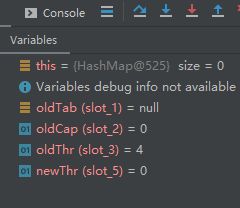
因为oldCap为0,进入else if,将newCap=oldThr,也就是这里才将容量设置为我们那个实例化HashMap的初始化容量的往上取二次幂的值

同时继续往下执行,因为newThr=0,根据负载因子计算出阈值,得到newThr=4*0.75=3,并真正赋值给全局变量,真正的阈值threshold
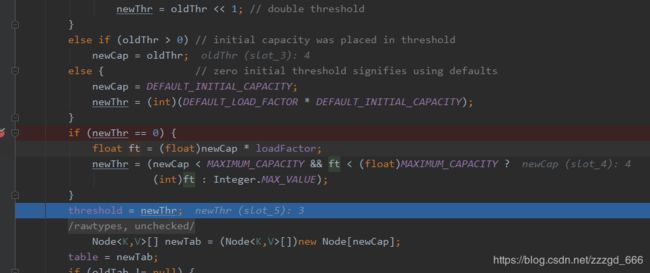
跳到resize方法结尾,看到几个变量现在的值如下
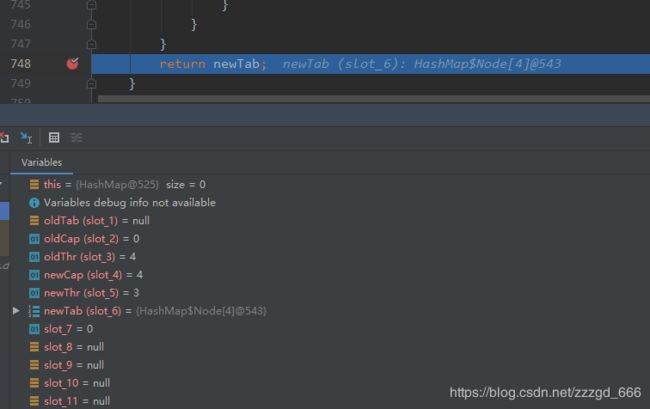
跳出resize方法,回到putval方法,到下一次可能resize的地方
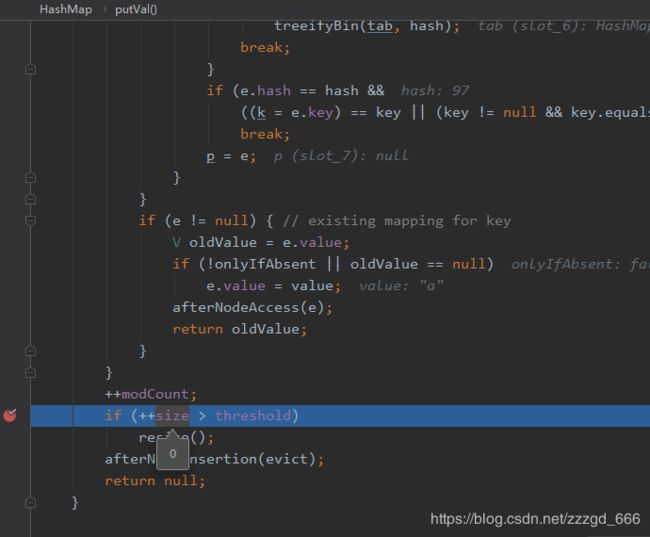
这里发现++0<3,所以不会进入resize方法
再到第二次put,按F8,发现前面的断点都没有触发,再一次到了if (++size > threshold)判断这里,这里size是1,也就是++1<3,不会进入resize方法
后面的put也是,没有进入resize方法。
上面是3个元素,设置容量为3.结论,只在第一次put的时候resize了一次。
b、 5个元素容量为5
如果是5个元素,容量为5呢?
根据上面我们知道,HashMap会在实例化的时候,将阈值临时设置为往上取二次幂,也就是8,第一次put的时候,设置容量为8,阈值是8*0.75=6
进入第一次put时的resize方法底部的断点可以看到,确实是这样
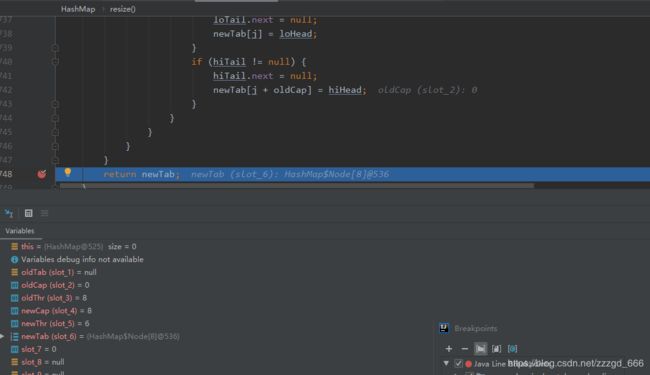
并且根据putval方法底部的
if (++size > threshold)
resize();
可以得知,第7次put,size为6(size从0开始)才会第二次调用resize方法。
结论 只会第一次put的时候resize
c、容量为7元素为7
这个时候同理容量会变成8,
到了第7次put的时候,size是6,if (++size > threshold)满足条件,第二次resize,容量变成16,阈值变成12
三、结论
根据debug可知,HashMap在实例化的时候不会初始化容量。第一次put的时候才会设置容量,阈值,并且会进行一次resize
我们在构造函数传的值,如果不是二次幂,都会往上取二次幂的值,比如5,得8,设置为容量
扩容除了第一次put的时候,还会发生在达到阈值的时候
其实阿里的公式也不是最精准的,在我们要存放的元素个数正好是阈值的时候,比如6,经过公式得到9,HashMap再取二次幂,容量为16,其实6个元素的话容量为8是可以刚刚好的,不过也不用太计较这些了